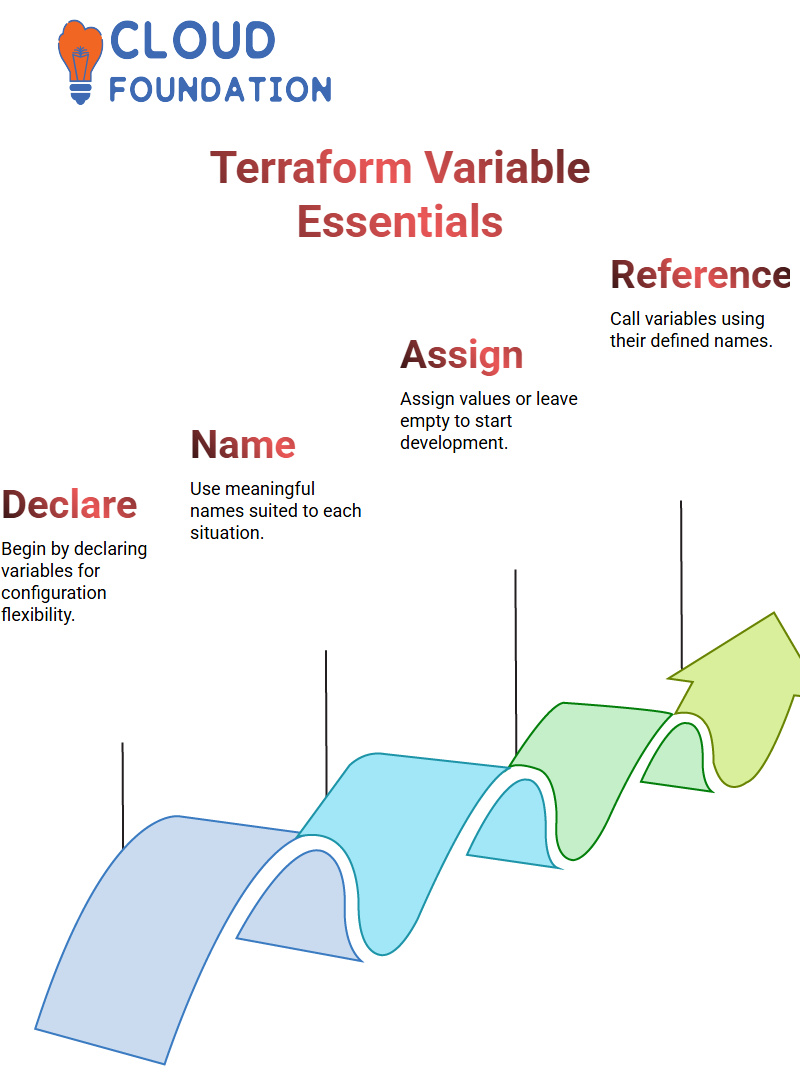Terraform Variable Training Manual
Understanding Terraform Variables
Terraform requires that users declare variables. Declaring variables allows you to understand their function because they dynamically control values.
You can name these variables however suits your situation best, giving you greater freedom when structuring configurations.
Once a variable has been declared, its next step should be assigning it a value. When this step seems cumbersome or unnecessary, Terraform provides flexibility by permitting it.
Declare your variable with an empty placeholder value before moving ahead with development.

Now comes the important part: How to call variables. In Terraform, referencing variables involves using their defined name followed by an assigned value as a reference for that variable.
This simple yet powerful functionality ensures configurations remain dynamic and reusable.
Terraform allows users to define variables across files, such as myvars. tfvars and terraform. tfvars – providing default values if one cannot be provided directly – an essential feature that helped me manage cloud resources using Terraform.
Terraform Variable Management
Terraform is an incredible tool that simplifies infrastructure management; let’s delve into its variables.
Terraform caused me some issues with my bucket name variable. Initially, the problem wasn’t immediately apparent. Still, after reviewing my variables file in detail, I realised that my variable didn’t align with its reference in my configuration file – something essential in Terraform. Ensuring variable names match correctly is key when working with this platform.
Let’s examine Terraform and how we handle variables in real-life scenarios.
Terraform’s approach for managing this task relies heavily on variables. We begin by setting an array variable called ‘S3_names’ that contains custom bucket names, such as “Production,” “Development,” and “Test,” etc. Once this list of names is set, Terraform uses them dynamically when configuring its configurations.
Terraform uses variables, not hardcoded names, for calling buckets containing S3 data, which are referred to as S3_names.
However, as these contain multiple values, we require a way to iterate over them correctly and consistently.
Indexing with ‘count.index’ provides Terraform with an effective means of traversing individual values from its variable list in a stepwise manner.
If set to five, Terraform attempts to access five names from our variable list. However, if we only provide four, it could cause errors. To prevent this, we use the length() function, which dynamically calculates the total number of items in our list.
Terraform’s length function ensures that, regardless of the number of values a variable contains, its count automatically adjusts to avoid mismatches between values in its list and Terraform’s database. With this function in place, dynamic lists can be managed efficiently in Terraform without requiring manual adjustments to the count.
Utilising Terraform variables and functions, such as “count.index” and “length”, makes automation both seamless and reliable, offering an effective means of organising resources efficiently.
Handling Errors in Terraform Variables
Errors in Terraform variable declarations can occur due to forgetting that variable names must start with either an alphabetical letter or an underscore character.
If an error message pops up, ensure your variable follows appropriate naming conventions by inspecting its declaration file.

Terraform can become confusing if special characters or spaces are entered by mistake into variable names; keeping these variable names free of spaces ensures a smooth workflow and helps ensure good productivity.
Terraform Resource Management
Terraform requires proper resource management when working with multiple resources.
I was creating various resources, but I ran into issues because duplicate references triggered an error due to Terraform’s requirement for unique reference names for every resource to prevent conflicts between resources.
By changing my reference names, Terraform successfully validated my configurations. This ensures that resources are created without duplicating errors.
Terraform Count Parameter
Terraform’s most helpful feature, the count parameter, is one of its greatest assets.
Instead of manually copying and pasting configuration files multiple times, Count allows us to quickly define multiple identical resources dynamically.
 As I needed to create 10 instances quickly and without writing multiple configuration files separately, using Terraform’s count parameter made the process efficient while eliminating redundant code while maintaining Terraform’s declarative approach.
As I needed to create 10 instances quickly and without writing multiple configuration files separately, using Terraform’s count parameter made the process efficient while eliminating redundant code while maintaining Terraform’s declarative approach.
Input in Terraform
Terraform also supports dynamically taking user input. I wanted to define variables without setting values in separate files; by commenting out pre-set values and using a description field instead, Terraform dynamically asked for my input.
This approach facilitates flexible configurations, where values can be set at runtime instead of being hardcoded into files, making Terraform an excellent tool for managing dynamic environments.
Terraform for Resource Creation
Terraform is an incredible tool for managing infrastructure efficiently. One common challenge associated with it lies in creating multiple similar resources dynamically; one solution lies in using either Terraform’s count and/or for_each parameters to achieve this.
One might wonder why there are two approaches when both seem to accomplish the same thing, yet both differ significantly in execution.
The key difference lies in the type of data – for a list, count is used, while map data requires for_each; both approaches are vital in creating variables in Terraform.
When given a map variable, use’ for_each’ to iterate through its key-value pairs and generate resources corresponding to each pair.
On the other hand, for variables that contain lists as data types, such as lists or arrays, count may provide more effective solutions when trying to create resources in sufficient quantity.
A key goal when using count is to create unique names for every resource created with Terraform.
Since Terraform requires unique identifiers for every asset you add to the environment, concatenating index values with resource names may help achieve this result.
Terraform automatically appends index numbers to reference names when using the count function, assigning a distinct reference to each instance of configuration and eliminating conflicts within it.
Modifying individual names beyond this standard practice would require loops and extra logic that may not be necessary when creating list-based resources.
Terraform’s count-based scaling approach ensures efficient scaling and unique identification of resources, making it a reliable option for infrastructure automation.
Dynamic Resource Management Terraform
Terraform empowers engineers to automate infrastructure provisioning using dynamic resource management techniques. When working with multiple instances, Count provides an intuitive and straightforward method for controlling the number of resources generated.
Assume you need five storage buckets; manually, this would involve copying and pasting each resource definition multiple times.
However, Terraform makes this task much more efficient with its “count” feature, allowing you to scale seamlessly by simply specifying one resource block with “count:5”.

Terraform assigns index values with great care. Beginning at zero and incrementing with each instance created, this feature ensures the creation of unique resources without manual configuration, while offering predictable resource deployment patterns.
Terraform plays a crucial role in modern infrastructure management, providing engineers with the flexibility to allocate resources dynamically. Engineers typically utilise count for list-based variables and for_each for map-based variables to optimise how infrastructure components are structured.
By leveraging Terraform’s capabilities, engineers can streamline large-scale deployments while efficiently automating routine tasks.
The Power of Infrastructure as Code in Terraform
Terraform has revolutionised how we manage infrastructure. Instead of manually configuring servers, networks, and resources one by one using legacy methods, such as FTP servers for deployments to workstations and network switches, Terraform enables faster, more consistent, and scalable implementations.
Terraform can make provisioning infrastructure easy! In just a few lines of code, you can build, update, and manage cloud services effortlessly across AWS, Azure or Google Cloud deployment platforms – giving you complete flexibility!
Terraform’s use of variables makes configurations more reusable and adaptable. For instance, when setting up a VPC with Terraform, you can define CIDR blocks to ensure best practices while remaining customisable.
Terraform goes beyond automating deployments — it offers teams control, efficiency, and reliability in writing infrastructure as code. Teams can easily version control their configurations while working collaboratively towards consistent environments across all environments.
Terraform makes getting started easy: define your resources, use variables, and apply configurations – management infrastructure becomes a predictable and structured process with Terraform!
 Terraform provides a valuable tool for those new to cloud computing, enabling them to learn infrastructure provisioning effectively and efficiently. Whether you’re deploying virtual machines, databases, or networking components, Terraform makes every step simpler.
Terraform provides a valuable tool for those new to cloud computing, enabling them to learn infrastructure provisioning effectively and efficiently. Whether you’re deploying virtual machines, databases, or networking components, Terraform makes every step simpler.
Terraform’s strength lies in its declarative approach, enabling users to specify the desired states, while Terraform ensures that the infrastructure aligns with these specifications.
Understanding Terraform is crucial to effectively managing cloud resources. As more organisations embrace infrastructure as code practices, Terraform remains one of the preferred solutions.
Terraform is more than a tool — it is an approach that defines modern infrastructure design. By learning Terraform, professionals enhance their ability to work efficiently within complex environments while automating deployments and troubleshooting configurations quickly.
Terraform’s state management makes infrastructure changes manageable without disrupting existing systems, while its flexibility enables integration across providers and cloud platforms and services.
Terraform stands as an advocate of automation, efficiency and the future of cloud computing. By revolutionising infrastructure management with teams developing, scaling and optimising their cloud environments efficiently.
Executing Terraform Configurations
After assigning values and variables, it’s time to execute your Terraform configuration. Making sure all variables are correctly referenced ensures a seamless processing experience within Terraform.
Executing the Terraform script initiates the creation of resources.
If issues arise, reviewing logs helps identify missing or incorrect values; Terraform provides clear error messages that simplify debugging efforts.
Calling Resources in Terraform
Terraform makes resource declaration and management straightforward with variable definition and variable use across configurations.
Create compute instances or manage storage using variables seamlessly, without needing to enter code manually.
Terraform takes care of everything for you, with three key steps that remain constant: resource declaration, variable definition, and call usage within configurations.
Understanding how to structure variables in Terraform leads to efficient deployment. Over time, this will become second nature.

Vinitha Indhukuri
Author



